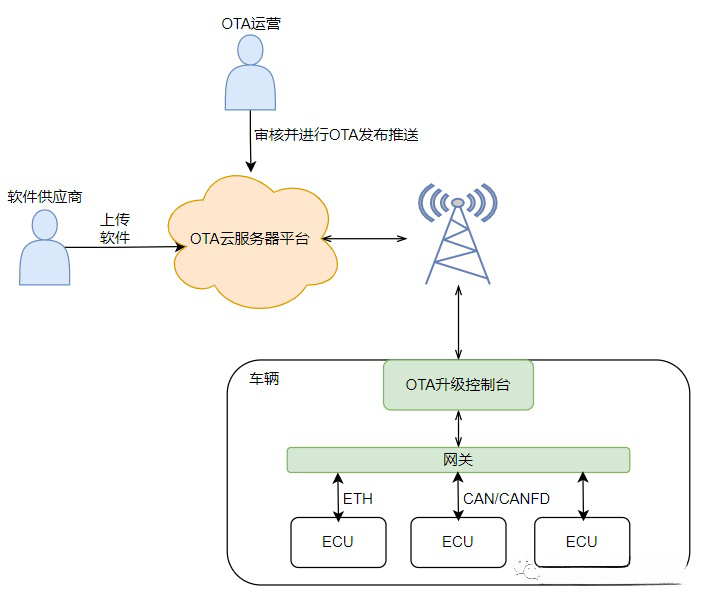
1. Overview
OTA (Over-The-Air) is a method for remotely updating device firmware or software through wireless communication technology.
This technology is widely used in modern IoT devices, smartphones, cars, embedded systems, etc., providing a convenient update method without physical connections.
The core of OTA updates is to enable devices to automatically, reliably, and securely obtain and apply updates from remote servers, improving device performance, adding new features, or fixing security vulnerabilities.

2. Working Principle
The basic process of OTA updates includes the following steps:
1. Firmware preparation and packaging: Developers package the latest firmware or software version and upload it to the OTA server. The packaging process usually includes compression, encryption, and adding version information and checksums.
2. Device checks for updates: The device periodically or under specific trigger conditions queries the OTA server for new firmware versions via the wireless network. This typically involves the device sending current firmware version information and receiving a response from the server indicating whether a new version is available.
3. Download update package: If a new version exists, the device downloads the firmware package from the server. During the download process, the device performs data verification (such as checksum or digital signature) to ensure data integrity and security.
4. Verification and installation: After the download is complete, the device verifies the integrity and authenticity of the firmware package, and upon confirmation, begins installation. During installation, the old firmware is replaced with the new one. To ensure system stability, many devices use a dual-partition (A/B partition) update mechanism, allowing updates to occur in the background while ensuring the system can roll back to a previous stable version.
5. Restart and apply updates: After installation, the device typically needs to restart to apply the new firmware. If the installation fails, the device may roll back to the previous firmware version.
3. Key Technologies
1. Firmware package management: Packaging the update content into firmware packages and publishing them via the server. The firmware package contains compressed data, verification information, and update scripts.
2. Version control: Managing and tracking device firmware versions to ensure orderly updates from the current version to the target version, preventing version conflicts and upgrade failures.
3. Security: Using encryption, digital signatures, checksums, and other measures to protect data during the update process, preventing tampering or forgery of the update package. Common encryption algorithms include AES (Advanced Encryption Standard), and digital signature algorithms like RSA.
4. Reliability: Supporting resume and recovery features to prevent update failures due to network interruptions or other faults. This often includes partial checksum and resume support for downloaded files.
4. Application Scenarios
1. Smartphones and tablets: Smartphones and tablets often receive system and application updates via OTA. For example, iOS and Android devices regularly receive operating system updates to provide new features, improve performance, and fix security vulnerabilities.
2. IoT devices: IoT devices such as smart home devices (smart bulbs, smart locks), sensor nodes, etc., achieve remote firmware updates through OTA, ensuring devices can adapt to new protocols and security requirements, enhancing user experience.
3. Automobiles: Modern cars equipped with infotainment and driver assistance systems can use OTA updates for remote software updates, enhancing functionality, adding new features, or fixing known issues.
4. Embedded systems: Various embedded devices such as smartwatches and fitness trackers use OTA updates to enhance features and improve user interfaces, maintaining competitiveness.
5. Implementation Solutions
(1) OTA update example using ESP32
ESP32 is a widely used MCU in IoT devices, providing a firmware development library that supports OTA updates. Below is a basic code example for implementing OTA updates using ESP32.
(2) OTA update example for Linux-based embedded systems
For Linux-based embedded systems (such as Raspberry Pi or BeagleBone), shell scripts or programs can be used to automatically download and update firmware.
6. Challenges and Future Development of OTA Updates
(1) Challenges
1. Reliability of network connections: OTA updates rely on stable network connections; interruptions may lead to update failures or devices not functioning properly.
2. Security issues: The update process may face security threats such as man-in-the-middle attacks and data tampering, necessitating data security during transmission.
3. Device storage limitations: Some low-power or small devices may not have enough storage space to accommodate the entire update package and firmware installation files.
4. Version compatibility: Updating firmware requires compatibility with existing hardware and software versions to avoid functionality loss or device failure due to incompatibility.
(2) Future Development
1. Intelligent update management: Future OTA update systems may become more intelligent, dynamically deciding when and how to update based on device usage and network conditions.
2. More efficient update mechanisms: Incremental updates (updating only the changed parts) may be used to reduce the size of update packages, saving bandwidth and storage space.
3. Enhanced security measures: More advanced encryption and authentication technologies may be adopted to improve the security of the update process and prevent malware injection.
4. Automation and autonomy: Devices may autonomously detect and repair potential issues, automatically roll back to stable versions, enhancing user experience and device reliability.
OTA (Over-The-Air) technology plays a crucial role in hardware development, simplifying device maintenance and enhancing flexibility and user experience. With the proliferation of IoT and smart devices, the application range and technical depth of OTA technology will continue to expand, providing reliable solutions for device functionality updates and security maintenance.
Note: This article is compiled for learning purposes. For the original text, please click the “Read Original” link below.